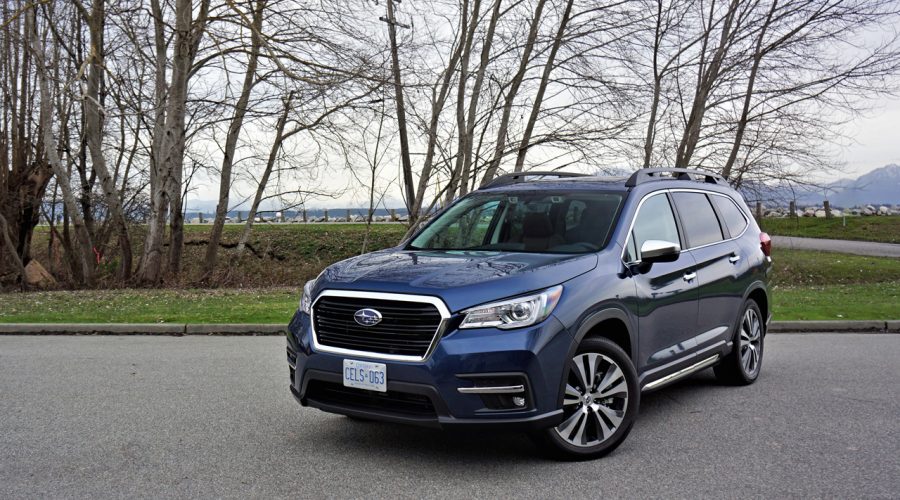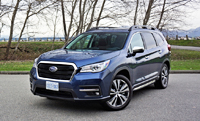
The mid-size crossover SUV segment has more than blown wide open in recent years, with every mainstream volume manufacturer now in the game and most making sure their entries are as fresh and advanced as possible.
Before the new 2019 Ascent arrived on the scene last fall, Subaru had been out of this market segment for a half decade. Its previous mid-size crossover, the 2005 to 2014 Tribeca, impressed in plenty of ways except for styling and third-row spaciousness, so Subaru made sure its Ascent was large enough and easier on the eyes.
Despite two-row crossover SUVs leading the mid-size sector in individual sales, Subaru already has the compact five-seat Forester and the mid-size Outback tall wagon, both very successful models, so therefore the Japanese brand made the choice to address those with larger families and a need for more gear-toting space. Others have done likewise, with Honda having made its three-row Pilot available for 17 years before its all-new two-row Passport showed up this summer, so maybe we’ll see a larger five-seat Subaru SUV at some point in the future.
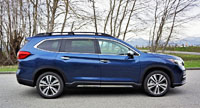
Until then, the North American-exclusive Ascent is configured for eight occupants in standard trim and seven with its optional second-row captain’s chairs, the latter setup being how Subaru outfitted my top-line Premier test model. It’s not a small SUV, measuring 4,998 millimetres (196.8 inches) front to back with a 2,890-mm (113.8-inch) wheelbase, while its overall height reaches 1,819 mm (71.6 inches) tall including its standard roof rails. Additionally, it spans 2,176 mm (85.6 inches) wide with its side mirrors extracted, while its track measures 1,635 mm (64.4 inches) up front and 1,630 mm (64.2 inches) at the rear.
To put it into perspective, the new Ascent is 48 mm (1.9 inches) shorter than the mid-size three-row SUV category’s best-selling Ford Explorer, albeit with a 24-mm (0.9-inch) longer wheelbase, while some might also be surprised to find out the new Subaru is 42 mm (1.6 inches) taller than the big blue-oval utility. The only Explorer measurements to exceed the Ascent span from side-to-side, which see Ford’s SUV stretching a sizeable 119 mm (4.7 inches) wider with 66 and 71 mm (2.6 and 2.8 inches) more front and rear track respectively. It should be noted the Explorer is one of the mid-size segment’s largest SUVs.
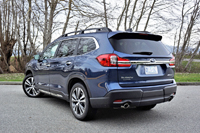
Comparing the new Ascent to other top-sellers shows that it’s longer, wider and taller than the Toyota Highlander and Kia Sorento (but shorter than the new Kia Telluride, with a shorter wheelbase and less width), longer and taller than the Honda Pilot and Hyundai Santa Fe XL (which is now outgoing, but it’s a fraction longer than the new Hyundai Palisade as well, although its wheelbase isn’t nor its width), wider and taller than the Nissan Pathfinder, merely wider than the Dodge Durango, and only taller than the Volkswagen Atlas.
By the way, that was only a partial list of the Ascent’s three-row mid-size crossover SUV challengers, the full list (from best-selling to least during the first three quarters of 2018) including the Explorer, Sorento, Highlander, Atlas, Pilot, Durango, Pathfinder, Chevrolet Traverse, Santa Fe XL, Dodge Journey, GMC Acadia, Mazda CX-9, and Ford Flex, plus the just-noted new Palisade and Telluride (which are too new to categorize by sales numbers, but should do well).
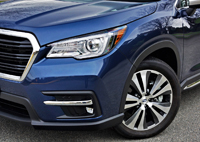
Even more important than exterior size is passenger volume and cargo space, which for the Ascent measure 4,347 litres (153.5 cubic feet) for the former and 2,449 litres (86.5 cu ft) for the latter when both rear rows are folded flat. Those numbers are just for the most basic of Ascent trims, incidentally, which also measures 1,345 litres (47.5 cu ft) behind the 60/40-split second row and 504 litres (17.8 cu ft) behind the 60/40-split third row, while all other trims are half a litre less commodious at 2,435 litres (86.0 cu ft) behind the first row, 1,331 litres (47.0 cu ft) aft of the second row, and 498 litres (17.6 cu ft) in the very back.
These figures compare well against key competitors, with the Ascent’s passenger volume even greater than the Explorer’s, and its standard eight-occupant seating configuration a rarity in the class, while the big Subaru’s maximum cargo capacity makes it one of the segment’s most accommodating too. Also important, rear passenger access is made easier thanks to second-row doors that open to 75 degrees.
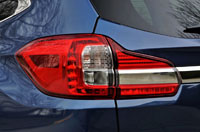
Being that the Ascent is a Subaru SUV, it includes standard full-time Symmetrical AWD, which has long proven to be one of the more capable all-wheel drive systems available. Its initial advantage starts with more evenly balanced weight distribution thanks to a longitudinally-mounted engine and transmission, its competitors’ AWD setups derived from FWD chassis architectures that house transversely-mounted motors, plus Subaru’s horizontally-opposed flat “boxer” engine allows for a lower centre of gravity, which improves handling and packaging.
Additionally, Symmetrical AWD applies more torque to the wheels with the most grip, and it’s done in such a way that traction not only improves when taking off from standstill in slippery conditions, but it also benefits overall control at higher speeds. This results in an SUV that’s plenty capable no matter the road or trail surface it’s traveling over, while its standard X-mode off-road system, complete with hill descent control, plus its generous 220 millimetres (8.66 inches) of ground clearance for overcoming obstacles, snow banks, etcetera, makes it better than the crossover SUV average for tackling rougher situations.
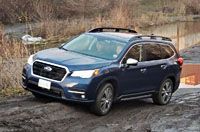
During our off-road test, all we needed to do was press the X-Mode button on the lower console and it responded almost as well as the low gearing range of a truck-based 4×4. You can hear the electronic traction and stability control systems going to work as it was searching for traction, and it went up some very steep, slippery, muddy patches that I would’ve normally only attempted with something with a bull-low gear set, like a Jeep Wrangler or Toyota 4Runner.
On that note the Ascent provides one of the nicest rides in its class too, something I really appreciated when off-pavement, but I won’t go so far as to say it’s the sportiest or best handling in this three-row category. It’s still capable of coursing through winding backcountry two-lane roads at a decent clip, but don’t expect it to increase your adrenaline levels unless high-speed body lean is your idea of a good time.
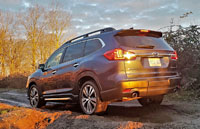
The new SUV utilizes the Subaru Global Platform (SGP), which combines rigid yet lightweight unibody construction with a fully independent MacPherson strut front and double-wishbone rear suspension setup, enhanced further by a stabilizer bar mounted directly to the body at the rear and electric rack and pinion steering up front. It all rolls on 18-inch silver five-spoke alloys shod with 245/60 all-seasons in the Ascent’s two lower trims, and 20-inch machine-finished high-gloss split-spoke rims on 245/50 rubber for the two upper trims, my tester benefiting from the latter.
And yes, good road-holding is important in an SUV that gets up and goes as quickly as the Ascent. Its horizontally-opposed 2.4-litre turbocharged four-cylinder engine provides strong performance off the line and plenty of passing power too, thanks to 260 horsepower and 277 lb-ft of torque, the latter maximized between 2,000 and 4,800 rpm, but I found it best when driven in a more relaxed manner where the powertrain was wonderfully smooth and didn’t use a lot of fuel.
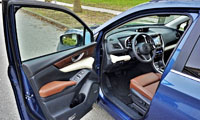
Subaru claims 11.6 L/100km in the city, 9.0 on the highway and 10.4 combined for the new Ascent, compared to 12.0, 8.7 and 10.5 respectively for the larger displacement 3.6-litre H-6 in the considerably smaller Outback. Considering new four-cylinder produces 4 more horsepower and 30 additional lb-ft of torque than that now aging flat-six, we’ll more than likely see this smaller, much more efficient turbocharged engine in a future Outback as well.
The Ascent also compares well against the base 2.3-litre turbo-four-powered Explorer that gets an estimated 13.1 city, 9.2 highway and 11.4 combined, although the Ford makes considerably more power, while the most efficient version of Toyota’s Highlander V6 AWD actually performs impressively with an almost identical rating to the Ascent, of 11.7, 8.8 and 10.4 respectively. Needless to say the Ascent competes at the pump very well considering its performance and size.
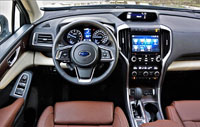
Aiding efficiency is the Ascent’s High-torque Lineartronic CVT, the continuously variable transmission not only thrifty but also ideal for mid-size crossover SUV applications due to smooth, linear power delivery. Subaru adds a standard set of steering wheel paddle shifters to improve driver engagement, along with a pseudo eight-speed manual mode that does a pretty good job of mimicking a regular transmission’s gear changes while featuring fairly sporty driving characteristics as well as standard Active Torque Vectoring to increase grip at high speeds. Subaru first introduced this advanced CVT for its WRX performance car, and while not set up to respond as sharply as it would in its world rally-inspired sport sedan, it still does a great job of combining positive, smooth shifts with minimal fuel consumption.

Unlike many of the Ascent’s mid-size rivals, its AWD is standard and powertrain a one-size-fits-all affair, no matter the trim level. On that note, the 2019 Ascent can be had in Convenience, Touring, Limited and Premier grades, with standard Convenience features not already mentioned including auto on/off halogen headlights, LED daytime running lights, roof rails, a 4.2-inch colour TFT multi-information display, three-zone automatic climate control, 6.5-inch touchscreen infotainment with Android Auto and Apple CarPlay smartphone connectivity, a rearview camera, six-speaker audio, satellite radio, three-way heated front seats, an eight-way power-adjustable driver’s seat, second-row USB ports, a total of 19 cup and bottle holders, and more for just $35,995 plus freight and fees.
Each and every 2019 Ascent trim also includes standard Subaru EyeSight driver assist technologies such as adaptive cruise control with lead vehicle start assist, pre-collision braking, pre-collision brake assist, pre-collision throttle management, lane departure warning, lane sway warning, and lane keeping assist, while all the expected active and passive safety features come standard too.
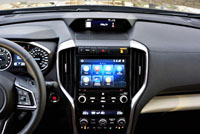
For $40,995 in eight-passenger trim or $41,495 with second-row captain’s chairs, which reduces the total seat count to seven, Ascent Touring trim adds the Subaru Rear/Side Vehicle Detection (SRVD) system that includes blind spot detection, lane change assist, rear cross-traffic alert and reverse automatic braking, as well as unique machine-finished five-spoke 18-inch alloys, body-colour side mirrors with integrated LED turn signals and approach lighting, LED fog lamps, a sportier rear bumper cap with integrated tailpipe cutouts, proximity keyless access, pushbutton ignition, front door courtesy lights, chrome inner door handles, a Homelink garage door opener, a windshield wiper de-icer, auto-dimming rearview and side mirrors, a leather-wrapped steering wheel and shift knob, larger 8.0-inch touchscreen infotainment, premium cloth upholstery, a powered panoramic sunroof, magazine pockets on the front seatbacks, second-row climate controls, third-row reading lights, a rear cargo cover, a powered liftgate, a transmission oil cooler, trailer stability control, and pre-wiring for a trailer hitch that increases towing capacity to 2,270 kg (5,000 lbs).
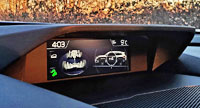
Limited trim, starting at $46,495 in standard eight-passenger layout or $46,995 in its seven-passenger configuration with second-row captain’s chairs, adds the larger 20-inch alloys mentioned earlier, plus steering-responsive full low/high beam LED headlights with automatic high beam assist, black and ivory soft-touch interior surfaces, a heatable steering wheel, an upgraded gauge cluster with chrome bezels and light blue needles (in place of red), and a 6.3-inch colour multifunction display atop the dash that shows the time, temperature and dynamic features such as an inclinometer, while a navigation system with detailed mapping is included within the infotainment display, as is SiriusXM Traffic, whereas additional Limited features include a 14-speaker 792-watt Harman/Kardon audio system, a 10-way power-adjustable driver seat upgraded to include powered lumbar support and cushion length adjustment, driver’s seat and side-mirror memory, a four-way power-adjustable front passenger seat, leather upholstery, two-way heatable second-row outboard seats, integrated rear door sunshades, third-row USB ports, and more.
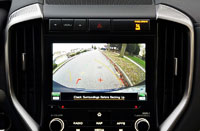
Top-tier Premier trim, which comes fully equipped at $49,995, even including standard captain’s chairs, adds an upgraded high-gloss black grille insert, satin-finish side mirror caps, chrome exterior door handles, rain-sensing wipers, ambient interior lighting, a front-view camera, a Smart Rearview Mirror with an integrated rear-view camera, woodgrain inlays, brown perforated leather upholstery, ventilated front seats, a 120-volt power outlet on the rear centre console, and more.
Incidentally, all 2019 Subaru Ascent pricing was sourced from CarCostCanada, where you can also find detailed pricing on trims, packages and standalone options for every other new model sold in Canada, plus otherwise hard to get rebate information and dealer invoice pricing that could save you thousands.
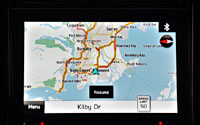
As for interior accommodations and finishings, the dash top in our Ascent Premier was mostly covered in a leather-look soft-to-the-touch synthetic, featuring stylish stitching across the middle in front of the passenger. Just below is a handy shelf that’s similar to the Highlander’s in function, while more leather-like composite, also stitched with real thread, supports that shelf across the lower portion of the dash before visually melding into the door panels, this surface treatment in a lovely ivory colour. The black and ivory colour theme is nicely complemented by brown armrests in the same tone as the aforementioned brown leather seats, while Premier trim also includes woodgrain inlays that don’t even try to look or feel genuine despite having a slight matte finish. I should also mention that elbow-pampering soft-touch door uppers can be found front and back, but don’t expect fabric-wrapped roof pillars as on some other mainstream mid-size SUVs.
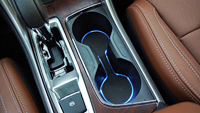
The primary instruments are nicely done, but this top-line model does not include a full digital gauge cluster, a feature that’s starting to show up in many of the Ascent’s recently new or redesigned competitors, such as the Volkswagen Atlas and Hyundai Palisade. Just the same, the dials’ blue needles are a nice touch instead of the usual red found in lower trims, while the vertical TFT multi-information display includes a nice graphic of the SUV’s backside with taillights that light up when you press the brake. It’s kind of fun to watch, but this display is even more useful for reminding drivers they may have left something, someone or some pet in the rear seating compartment by notifying via a visual alert and audio alarm chime, as well as other functions.
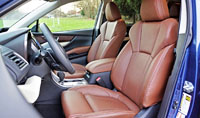
This said the larger multi-information display atop the dash goes to work when the aforementioned EyeSight ADAS systems are put into action, with really attractive and detailed graphics, while this display also provides speed limit information, navigation system info, an inclinometer and other off-road features, and more.
Just below on the centre stack, the Ascent gets Subaru’s beautiful new high-resolution 3D-like infotainment touchscreen that we first enjoyed in the new Forester and WRX models. It’s a giant step up in visual attractiveness and functionality, getting all of the features and apps noted previously while I listed off standard and optional items, while responding to input quickly and reliably.
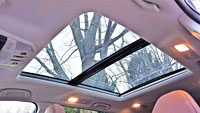
Speaking of quick response times, the heated steering wheel rim and three-way heatable front seats come on quickly and remain hot as well, instead of slowly cooling off like so many others are programmed to. The switch for steering wheel heat is logically located just under the right-side spoke where it’s easy to find, while the adaptive cruise control system, activated via buttons just above, works perfectly in both high-speed and stop-and-go situations. Similarly, the lane departure system held the Ascent in place when cruising down the freeway, but it tended to bounce off the lines instead of maintaining the centre of a given lane when my hands weren’t on the wheel (not that I recommend driving without hands on the wheel, but I was testing the system out).
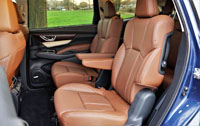
Speaking of technologies, the Ascent Premier’s centre mirror gets pretty close to mirroring a sophisticated smartphone or tablet. It does double-duty as a backup camera when a switch just below is flicked rearward, whereas pulling that lever forward causes it to revert to a regular auto-dimming mirror. Less sophisticated yet also appreciated, the Ascent’s handy sunglasses holder doubles as a conversation mirror.
The seats are extremely comfortable and wide, good for large people yet also accommodating for my five-foot-eight medium-build body type. With the driver’s seat set up for my long-legged, short-torso frame, meaning that it was pushed farther rearward than it would be with some other people of my stature, I still had no problem comfortably reaching the steering wheel when the column was extended as far back as possible, plus when walking around to the second row and climbing in directly behind the driver’s seat I found the rear passenger accommodations very spacious and comfortable. In fact, there was about 10 inches of nothing between my knees and the front seatback, plus more than enough room to move my head and shoulders around.
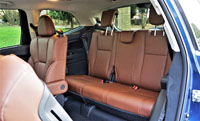
Even more amazing, with the middle row pushed as far back as possible I still had ample room in the third row. To be clear, my knees were touching the second-row seatbacks, so moving those seats forward a smidge would’ve made it easier to move around in the very back, but I had close to three inches over my head, meaning the third row could be used for average-sized adults, even when larger adults are sitting in the first two rows.
As noted earlier, there’s a fair bit of room behind the rearmost seats for gear, this space about as large as a full-size sedan’s trunk, while below the load floor there’s another compartment for stowing what-have-you along with the retractable cargo cover when not in use. Folding the 60/40-split third row down is a little bit awkward, but it works well enough. First you’ll need to manually slide the headrests into the seatbacks, and then tug a strap on top of the seats before pushing the seats forward. To get them back up, just pull the longer strap that’s attached to the cargo floor/seatback. The second row folds down by first unlatching it, so you can slide it forward, and then unlatching a second release at which point you can slide them back if you want to match up each side. There’s certainly a lot of space for luggage or building materials, but the captain’s chairs don’t form a very flat loading surface. I’m guessing it would work better with the standard bench seat, so if you’re doing a lot of hauling you may want to purchase one of the Ascent’s lesser trims.
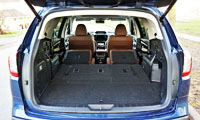
As far as purchasing an Ascent at all, I think Subaru has done a very good job with its second-ever mid-size SUV. First, it looks like a Subaru, albeit on steroids, and should be attractive to those buying into this category, while its overall size and ability to haul plenty of passengers in comfort plus loads of cargo should appeal to all but those looking for a full-size utility. The Ascent’s fit and finish is quite good for the class, electronics very good, standard and optional features set impressive, performance and fuel economy compromise spot on, and overall feeling of quality more than up to par. Therefore if you like Subaru and you need to add space and utility to your mobility, the Ascent is well worth your time and attention.

